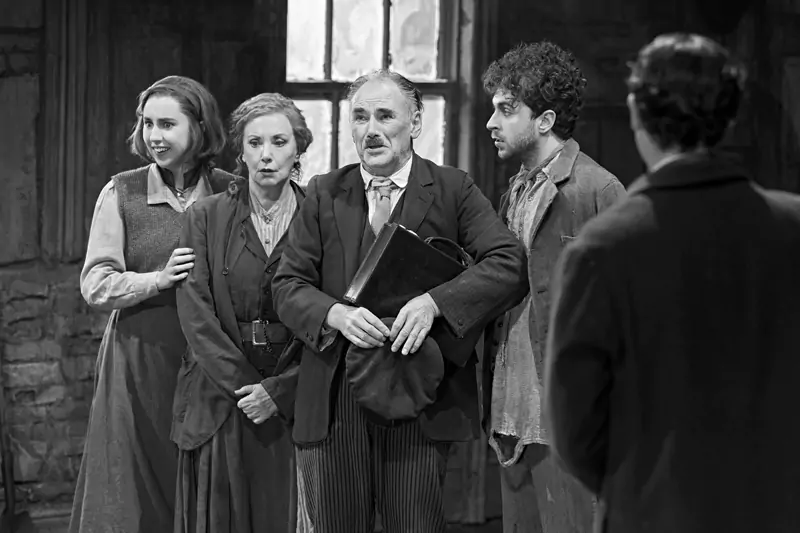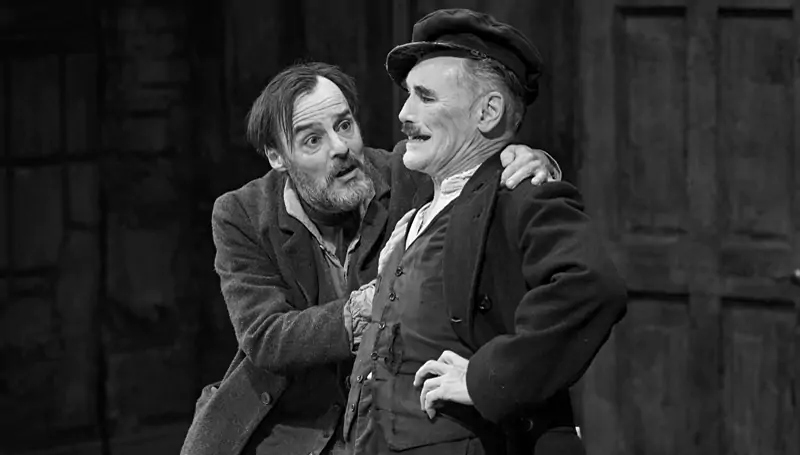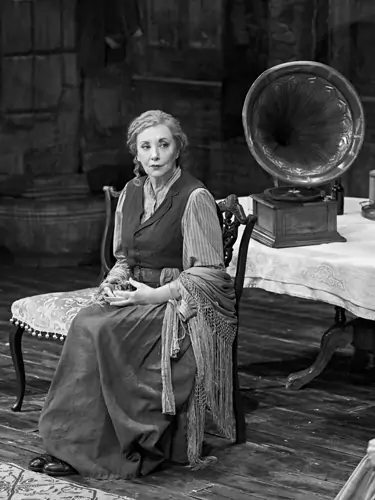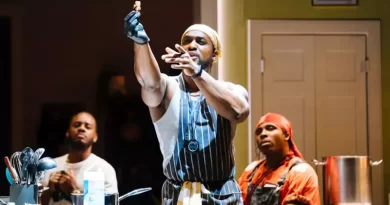“Juno and the Paycock” at Gielgud Theatre
Jeremy Malies in the West End
9 October 2024
A maimed young man, two paramilitary executions, disappointment over an inheritance, abject poverty, and an unwanted pregnancy. If you come to Seán O’Casey’s 1924 play Juno and the Paycock (it takes place against a backdrop of the Irish Civil War) hoping for light entertainment then, to quote J. Smith-Cameron playing Mary Boyle, you’re in the wrong shop!
J. Smith-Cameron as Juno.
Photo credit: Manuel Harlan.
That is not to say that it’s unremitting gloom. Mark Rylance as “Captain” Jack Boyle, the strutting peacock of the title, references Charlie Chaplin to good effect during the opening acts. I was puzzled by this but then reflected that at the time Chaplin was the most famous man on earth and instantly recognizable in a way that, say, Éamon de Valera was not.
Like Chaplin, Rylance’s character is creating a (seafarer) identity outside himself, perhaps fired by the American Dream. Rylance uses Chaplinesque elements including the tramp’s shabby gentility, dancing eyes, birdlike head-cocking, and Indian-rubber quality as he helter-skelters around the set and even vaults across tables. Add the music-hall songs and the approach falls into place.
There are some of the familiar gestures and vocal mannerisms that Rylance used as Johnny “Rooster” Byron in Jerusalem but the characters are of the same age and both are picaresque. It can’t be a criticism. Comedy includes never being sure which of his two gammy legs is the worse afflicted and thus currently stopping him from doing a day’s work. Boyle is signed on the dole alright (but has exhausted certain benefits) and director Matthew Warchus prompts us to reflect on Universal Credit, the welfare state, and the allegedly workshy in our own day.
What Rylance makes clear is that while his character will spit out bigoted sentiments, he is only an armchair patriot and would not involve himself for real in the war around him. Rylance’s main achievement is to distinguish occasional glints of shaded pathos from the overall bombast that O’Casey has given the character.
Off-stage sound effects (including troops being drilled) in a design by Simon Baker remind us of the grisly guerrilla combat. Irish nationalists are fighting countrymen who support the Anglo-Irish Treaty. But the messages and particularly the stage design by Rob Howell (which could be used for a modernist opera) broaden things out to a Europe-wide Catholic tradition. Matters are certainly not just regional, and I thought often of Lorca. It’s therefore odd to reflect that O’Casey was a non-believer from a Protestant background. Howell overshadows the tatty furniture with a towering backdrop in shades of crimson that suggest whole ammo dumps being exploded in the conflict on the streets outside.

The company.
Photo credit: Manuel Harlan.
Opposite Rylance as Boyle’s wife Juno is American stage and screen star J. Smith-Cameron. She soon convinces us of the stoicism that will sustain her character when great expectations come crashing down. The actor also projects sheer bravery, tenderness, and the remaining glints of glamour that still hold her husband transfixed. Smith-Cameron is alive to all the humour in the dialogue and proves compelling with a signature searing prayer-reprimand to her Maker after the death of son Johnny played by Eimhin Fitzgerald Doherty. Johnny is an initially brave nationalist who becomes a turncoat and sides with an Irish Free State faction only to be assassinated for betraying his former quartermaster. At all times we are reminded that this is a city of secret armies.
The Irish brogues are not overwhelming and there don’t seem to be too many strictures about Dublin rhythm. Instead, voice and dialect coach Martin McKellan helps the cast to focus on relish for words. It’s reminiscent of Brian Friel’s Translations which might take place 90 years earlier but also involves nationalism and British influence. Warchus puts us in a linguistically aware world where language matters for both meaning and its musicality.
Support across the board is strong, notably from Paul Hilton as Boyle’s vile hanger-on Joxer. O’Casey surely has Henry IV Part 2 in mind with the offstage taverns, the carousing, and lack of loyalty among these wastrels. The theme is even stronger in The Plough and the Stars which appeared two years later.
Joxer is willing to steal a sausage from his host’s plate and pocket it for later. It’s a reminder that the characters are all near to starvation (Juno tells Boyle that this may be his last breakfast for a while in one of the opening lines) and we see Joxer not only predate but finally spit on his more charismatic drinking partner. Hilton deserves plaudits for sustaining laughter during the duologues but not allowing them to descend into mere comic turns. As Juno’s daughter (the character is on strike for a living wage) Aisling Kearns shows technical skill in mimicking vocal and physical aspects of her mother.
Back to Howell and the set, in a play that must be a riot for any designer. With the upturn in the Boyles’ fortunes, the few existing sticks of furniture are replaced (on tick) by the best that shops in Grafton Street can offer during the few days of expected wealth. Furniture and ornaments are then taken away leaving the vast tenement room looking like a warehouse.
Warchus ignores O’Casey’s prolix directions to good effect by placing the cooking range almost on the apron of the stage. Everybody, in all tiers of the theatre, shares in the comic business as Rylance even produces musical notes by striking pots and pans. But the best verbal gag of the evening (Boyle criticizes his daughter for reading children’s books such as A Doll’s House, Ghosts, and The Wild Duck) got not so much as a titter on press night even in the premium part of the stalls.
The final drinking bout in the last act takes an expressionist turn. This is grim – devoid of sentimentality as it should be – but at turns riotously funny while always avoiding melodrama. The Boyles think that an inheritance is going to lift them out of the Dublin slums, and perhaps with this optimism they tell us that the greatest danger in life is hope.










